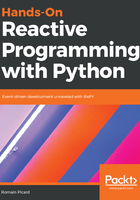
Summary
You should now understand what event-driven programming is, what reactive programming is, and what are the common points and differences between them. It is important to remember that event-driven programming is not a programming paradigm, but a way to structure the code flow. Knowing the basics of the reactor and proactor design patterns is also important to better understand how the frameworks that will be used in the next chapters work.
From now, you can start writing reactive code for tasks that you may have written in a sequential way. This kind of exercise, even for very simple algorithms, is good training in how to structure your code as a data-flow instead of a code-flow. Switching from a code-flow design to a data-flow design is the key point in writing ReactiveX applications.
Last but not least, you should now be able to navigate easily in the ReactiveX documentation and understand more easily the behavior of each operator, thanks to marble diagrams. Never hesitate to use them when you need to write your own operator or component. This is always a good way to show what you want to achieve. For a more dynamic view, reactivity diagrams will help you design bigger components or document how they are composed together.
The next chapter will introduce how asynchronous programming is done in Python, and, more specifically, with its dedicated module of the standard library, AsyncIO. But before that, detailed explanations of the underlying principles of asynchronous functions will be provided so that you can understand what's going on under the hood.